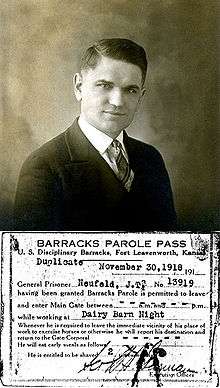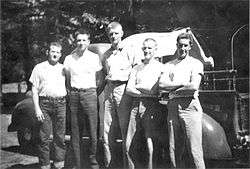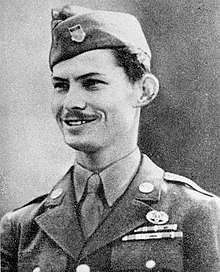Conscientious objection in the United States
Conscientious objection in the United States is based on the Military Selective Service Act,[1] which delegates its implementation to the Selective Service System.[2] Conscientious objection is also recognized by the Department of Defense.[3]
The Department of Defense defines conscientious objection as a "firm, fixed, and sincere objection to participation in war in any form or the bearing of arms, by reason of religious training and/or belief".[3] It defines "religious training and/or belief" as:
Belief in an external power or "being" or deeply held moral or ethical belief, to which all else is subordinate or upon which all else is ultimately dependent, and which has the power or force to affect moral well-being. The external power or "being" need not be one that has found expression in either religious or societal traditions. However, it should sincerely occupy a place of equal or greater value in the life of its possessor. Deeply held moral or ethical beliefs should be valued with the strength and devotion of traditional religious conviction. The term "religious training and/or belief" may include solely moral or ethical beliefs even though the applicant may not characterize these beliefs as "religious" in the traditional sense, or may expressly characterize them as not religious. The term "religious training and/or belief" does not include a belief that rests solely upon considerations of policy, pragmatism, expediency, or political views.
— Department of Defense, Instruction 1300.06[3]
Conscientious objection must be "sincere and meaningful" and occupy "a place in the life of its possessor parallel to that filled by an orthodox belief in God".[4] Any mixture of sincere religious, moral, or ethical beliefs can qualify as conscientious objection.[5] The term "religious training and belief" does not include essentially political, sociological, or philosophical views, or a merely personal moral code.[1] A conscientious objector may have political, sociological, and philosophical views, but such views are not a replacement for religious and/or moral beliefs.[3]:5
A conscientious objector may still be willing to use force to defend themselves or others, and may even support a state's right to go to war, as long as the individual objects to personal participation in such armed conflict between states or groups.[6]:5
History
American Revolutionary War
During the American Revolutionary War, exemptions varied by state. Pennsylvania required conscientious objectors who would not join companies of voluntary soldiers, called Associations, to pay a fine roughly equal to the time they would have spent in military drill.[7]:2 Quakers who refused this extra tax had their property confiscated.
American Civil War
Conscription in the United States began in the Civil War. Although conscientious objection was not initially part of the draft law, individuals could provide a substitute or pay a commutation fee of $300 ($4,674.34 in 2017[8]) to hire one.[7]:3 A July 4, 1864, amendment to the draft law ended commutation except for those draftees who were "conscientiously opposed to the bearing of arms."[9] Conscientious objectors in Confederate States initially had few options. Responses included moving to northern states, hiding in the mountains, joining the army but refusing to use a weapon, or being imprisoned. Between late 1862 and 1864 a payment of $500 ($7,790.56 in 2017[10]) into the public treasury exempted conscientious objectors from Confederate military duty.[7]:4
We were cursed, beaten, kicked, and compelled to go through exercises to the extent that a few were unconscious for some minutes. They kept it up for the greater part of the afternoon, and then those who could possibly stand on their feet were compelled to take cold shower baths. One of the boys was scrubbed with a scrubbing brush using lye on him. They drew blood in several places.
World War I

In the United States during World War I, conscientious objectors were permitted to serve in noncombatant military roles. About 2000 absolute conscientious objectors refused to cooperate in any way with the military.[7]:11 These men were imprisoned in military facilities such as Fort Lewis (Washington), Alcatraz Island (California) and Fort Leavenworth (Kansas). Some were subjected to treatment such as short rations, solitary confinement and physical abuse severe enough as to cause the deaths of two Hutterite draftees.[11]:545
Eventually, because of the shortage of farm labor, the conscientious objectors were granted furloughs either for farm service or relief work in France under the American Friends Service Committee. A limited number performed alternative service as fire fighters in the Cascade Range in the vicinity of Camp Lewis, Washington[7]:147 and in a Virginia psychiatric hospital.[7]:213
World War II
During World War II, all registrants were sent a questionnaire covering basic facts about their identification, physical condition, history and also provided a checkoff to indicate opposition to military service because of religious training or belief. Men marking the latter option received a detailed form in which they had to explain the basis for their objection.[7]:77–78

Civilian Public Service (CPS) provided conscientious objectors in the United States an alternative to military service during World War II. From 1941 to 1947 nearly 12,000 draftees,[7]:452 unwilling to do any type of military service, performed work of national importance in 152 CPS camps throughout the United States and Puerto Rico.[12]
Alternatives to war bonds and war savings stamps were provided for those who would not fund the war for conscientious reasons. The National Service Board for Religious Objectors offered civilian bonds and the Mennonite Central Committee offered Civilian Public Service stamps and War Sufferers' Relief stamps.
Civilian Public Service was disbanded in 1947. By the early 1950s a replacement program, 1-W service, was in place for conscientious objectors classified as 1-W by Selective Service. The new program eliminated the base camps of CPS and provided wages for the men.
1-W service was divided into several categories. The Earning Service involved working in institutions such as hospitals for fairly good wages. Voluntary Service was nonpaying work done in similar institutions, mostly within North America. Pax Service was a nonpaying alternative with assignments overseas. 1-W Mission Supporting Service was like the Earning Service but the wages were used for the support of mission, relief or service projects of the draftees choice. The nonpaying services were promoted by church agencies as a sacrifice to enhance the peace witness of conscientious objectors.[13]:260–269

Conscientious objectors with Medals of Honor
Desmond T. Doss, a Virginia native and Seventh-day Adventist, desired to perform military service after the start of World War II. While enlisting with the intention of becoming a combat medic, Doss tried to claim noncombatant status but was told that the military did not recognize the designation. He was informed that he should register as a conscientious objector. Doss personally preferred to be called a "conscientious cooperator" because he would willingly serve his country, wear a uniform, salute the flag, and help with the war effort.[14] Nevertheless, Doss accepted the designation "conscientious objector" in order to join the army and avoid a Section 8 discharge on account of his religious convictions.[15]
On October 12, 1945, Desmond Doss received the Medal of Honor from President Harry S. Truman. This medal is the highest award for valor in action against an enemy force. By helping to support and maintain the war, Desmond was the first non-combatant to receive the Medal of Honor. A dramatized account of Doss's life and war experience, as well as testimony from his peers, is portrayed in Mel Gibson's 2016 film Hacksaw Ridge, starring Andrew Garfield as Doss.
Other conscientious objectors who have been awarded the Medal of Honor are Thomas W. Bennett and Joseph G. LaPointe, both medics who served during the Vietnam War. Both Bennett and LaPointe were killed in combat within four months of each other in 1969 and were awarded their medals posthumously.
Selective conscientious objection
"The individual's objections must be to all wars rather than a specific war."[3]:3 Objection to participation in a specific war is called selective conscientious objection, which the United States does not recognize. A conscientious objector may still be willing to participate "in a theocratic or spiritual war between the powers of good and evil".[3]:3
Conscientious objection in the Selective Service System
During a draft, the Selective Service System assigns classifications to draftees. A person classified as 1-A is considered available for military service. Conscientious objectors available for noncombatant military service are classified as 1-A-O, while those who oppose all military service are classified as 1-O and available for civilian work.[16]
Alternative service
During a draft, as part of the Alternative Service Program, the Selective Service System will consider 1-O (civilian) conscientious objectors to be Alternative Service Workers (ASWs), required to work for members of the Alternative Service Employer Network (ASEN).[17]
Conscientious objection in the United States military
The Department of Defense also implements the classification of conscientious objectors into its own system.[3] The Navy,[18] the Marine Corps,[19] the Army,[20] the Air Force,[21] and the Coast Guard[22][23] each provide their own policies on conscientious objection.
Application within the military
When the draft is not in effect, only those who have enlisted themselves can apply for or receive formal conscientious objector status. Such a person is only eligible for classification as a conscientious objector only if their beliefs are determined to have "crystallized" after receipt of an induction notice.[3]:3 The Selective Service System does not accept requests for classification as a conscientious objector when the draft is not in effect. If the draft is reinstated, a draftee will have a short period of time after enlistment to request classification as a conscientious objector.
A person who is already enlisted can file for classification as a 1-A-O conscientious objector to be assigned to two years of noncombatant service or civilian work "contributing to the maintenance of the national health, safety, or interest".[1]
Noncombatant service
Noncombatant service is any military service that is unarmed at all times and does not require weapons training.[3]:2 Service aboard an armed ship or aircraft or in a combat zone is considered to be noncombatant unless the service requires personal and direct involvement in the operation of weapons.[3]:2
Investigative process
For serving personnel of the United States military, conscientious objection applications are "subject to an investigative process by a senior officer not in the applicant's chain of command", as well as "an interview of the applicant by a military chaplain as well as a psychiatrist or medical officer". The officer conducts an informal hearing at which the sincerity of the applicant's convictions is examined. By whom the decision is made varies by military branch.[24]
Acceptance rates
Conscientious objector applications for enlisted soldiers are reviewed on a case-by-case basis by the individual's respective branch of the military. Between 2001 and 2007, Army acceptance rates for conscientious objector applications varied. Of the few applications the Army received (between 18 and 39 per year) between 49% and 78% were accepted per year.[25]
See also
- Alternative civilian service
- Alternative Service Program
- Civilian Public Service
- Conscientious objector
- Conscription in the United States
- Selective Service System
Supreme Court cases
- Cox v. United States (1947), 332 U.S. 442 (U.S. 1947).
- Gardiner v. Tarr, 341 F. Supp. 422 (D.D.C. 1972).
- Gillette v. United States, 401 U.S. 437 (U.S. 1971).
- Parisi v. Davidson, 405 U.S. 34 (U.S. 1972).
- United States v. Seeger, 380 U.S. 163 (U.S. 1965).
- Welsh v. United States, 398 U.S. 333 (U.S. 1970).
- Witmer v. United States, 348 U.S. 375 (U.S. 1955).
References
- "Conscientious Objection and Alternative Service". Selective Service System.
- "Department of Defense Instruction 1300.06" (pdf). May 31, 2007.
- United States v. Seeger (1965).
- Welsh v. United States (1970).
- Galvin, Bill (August 2009). The Guide for COs in the Military (PDF). Center on Conscience & War. Retrieved May 2, 2017.
- Gingerich, Melvin (1949). Service for Peace, A History of Mennonite Civilian Public Service. Mennonite Central Committee.
- "300 1865 USD in 2017 USD". WolframAlpha.
- James W. Geary, We Need Men: The Union Draft in the Civil War, p. 138, citing the text of the amendment.
- "500 1865 USD in 2017 USD". WolframAlpha.
- Smith, C. Henry (1981). Smith's Story of the Mennonites. Revised and expanded by Cornelius Krahn. Newton, Kansas: Faith and Life Press. ISBN 0-87303-069-9.
- Siuslaw National Forest; History Department; Portland State University. "Camp 56: An Oral History Project: World War II Conscientious Objectors and the Waldport, Oregon Civilian Public Service Camp" (PDF). Center for Columbia River History. Archived from the original (PDF) on 2013-06-04. Retrieved August 15, 2013.
- Pannabecker, Samuel Floyd (1975). Open Doors: A History of the General Conference Mennonite Church. Faith and Life Press. ISBN 0-87303-636-0.
- "Private First Class Desmond T. Doss Interview". March 20, 1987.
- Benedict, Terry (Director) (March 2004). The Conscientious Objector (Motion Picture). United States.
- "Classifications". Selective Service System.
- "Alternative Service Employer Network". Selective Service System.
- "MILPERSMAN 1900-020" (PDF). Navy Personnel Command. August 22, 2002.
- "Marine Corps Order 1306.16F" (PDF). United States Marine Corps. June 11, 2013.
- "Army Regulation 600–43" (PDF). Federation of American Scientists. August 21, 2006.
- "Air Force Instruction 36-3204" (PDF). Air Force E-Publishing. April 6, 2017.
- "COMDTINST 1900.8" (PDF). United States Department of Defense. November 30, 1990. Archived from the original (PDF) on April 18, 2020.
- "COMDTINST M1000.4" (PDF). United States Department of Defense. March 23, 2015. Archived from the original (PDF) on September 24, 2017. Retrieved June 2, 2018.
- Conscientious objection to military service (PDF). United Nations Human Rights. 2012. pp. 63–64. ISBN 978-92-1-055405-3.
- "Conscientious Objectors". The United States Army. August 2, 2007. Retrieved May 3, 2017.
Further reading
- Capozzola, Christopher. Uncle Sam wants you: World War I and the making of the modern American citizen (2008).
- Eller Cynthia. Conscientious Objectors and the Second World War: Moral and Religious Arguments in Support of Pacifism (1991).
- Flynn, George Q. Lewis Hershey and the Conscientious Objector: The World War II Experience. Military Affairs 47 (February 1983) 1-6.
- Goossen, Rachel Waltner. Women against the good war: conscientious objection and gender on the American home front, 1941-1947 (Univ of North Carolina Press, 1997) Online
- Hall, Mitchell K. ed, Opposition to War: An Encyclopedia of U.S. Peace and Antiwar Movements (2 vol, ABC-CLIO 2018).
- Howlett, Charles F. "Studying America's Struggle against War: An Historical Perspective." History Teacher 36#3 (2003): 297-330. Online
- Kohn Stephen M. Jailed for Peace: The History of American Draft Law Violators, 1658-1985 (1986).
- Sibley, Mulford Q. and Philip Jacob. Conscription of Conscience: The American State and the Conscientious Objector, 1940-1947. (1952)
- Tannenbaum, Seth S. "Activism without 'Radicalism': American Activism on Behalf of Conscientious Objectors during World War I." Peace & Change (2017) 42#1, pp 32–63.
- Taylor, Steven. Acts of conscience: World War II, mental institutions, and religious objectors (Syracuse UP, 2009).
Primary sources
- Frazier, Heather T. and John O Sullivan, eds. We Have Just Begun to Not Fight: An Oral History of Conscientious Objectors in Civilian Public Service in World War II (Twayne, 1996).